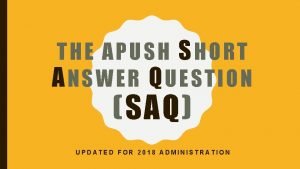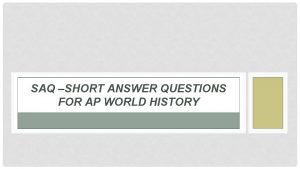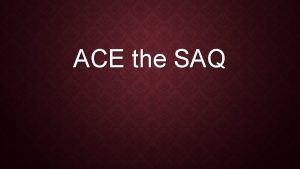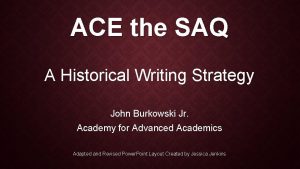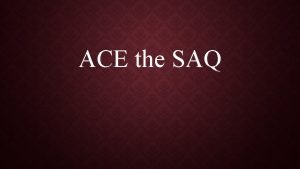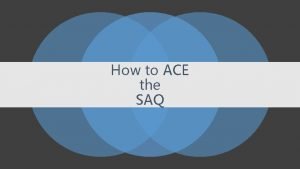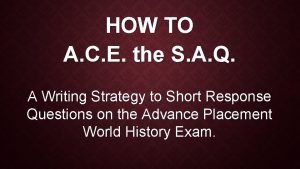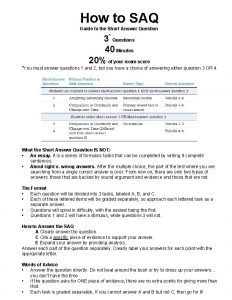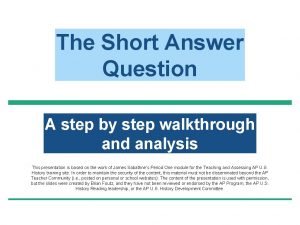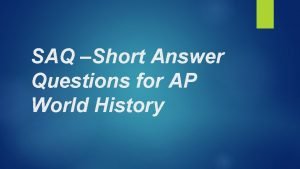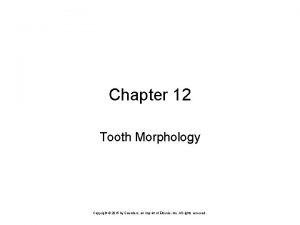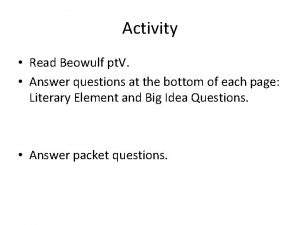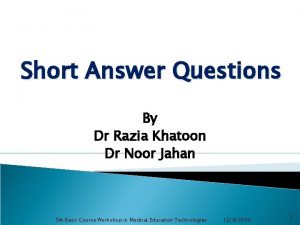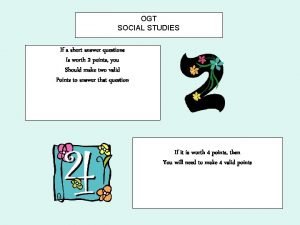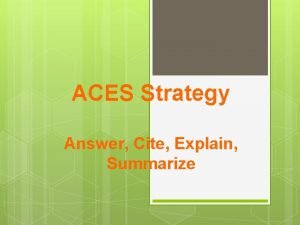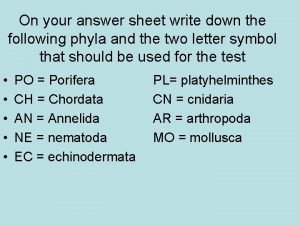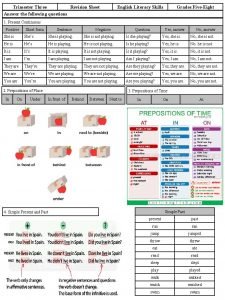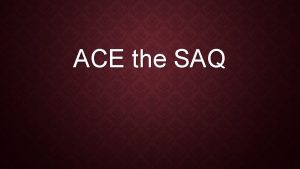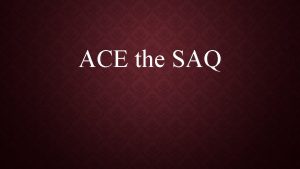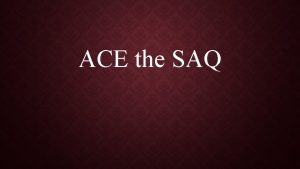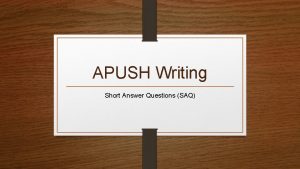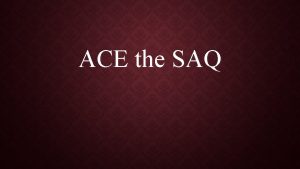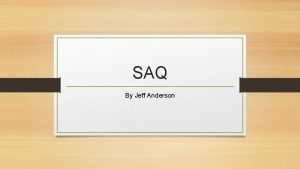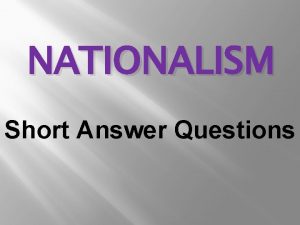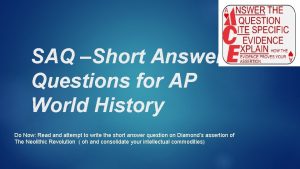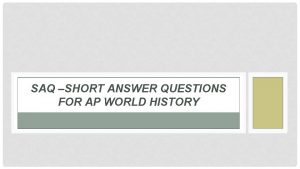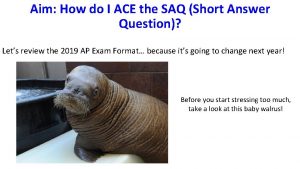Short Answer Questions How to ACE the SAQ





































- Slides: 37

Short Answer Questions How to ACE the SAQ!

Purpose of SAQs The purpose of SAQs is to demonstrate that you can understand an author’s position interpret primary and secondary sources provide historical context develop arguments in a clear, organized and brief manner.

Basic Information 4 questions each with 3 parts Total time: 50 minutes (that is 12. 5 per question) 20% of your score Label A, B, C or bullet point the separate parts to make them easy to read - no paragraphs! May be stimulus based - image, quote, etc. At least 2 will have some form of “internal choice” Use complete sentences – do not bullet-point Responses should be 2 -4 sentences in length Stay within the writing box – anything outside the box will not be scored

Scoring 0 -3 points per set of questions – one point per part, scored separately Readers decide if it meets the “threshold” Can receive a point for B even if get A wrong, etc. Inaccurate info? Reader’s discretion - how much accurate vs. inaccurate? How big were the errors? Could a 6 th grader write what you wrote? If yes, then NO point awarded!

How to Answer an SAQ Maximize Your Score

ACE the SAQ A = Answer the Prompt Directly answer the question by identifying your claim. C = Cite Specific Evidence Include a key term/event/person/concept to support your claim. E = Explain Expand on the evidence by explaining its importance and how it connects to the prompt.

Read the Prompt What are they asking you to do? Briefly explain ONE difference…. Note if they are asking for a specific difference (economic, political, social, cultural) What time period must I stay within? (Not every prompt has a time period).

Common Stems in SAQs Explain one development…(or historical event). . . Explain the author’s point of view. . . Identify the historical context. . . Explain ONE implication. . . Explain the impact of… Explain how ONE element supports the point of view… Explain the main point. . .

More Common Stems Explain ONE similarity (or difference). . . Explain ONE factor that accounts for the difference… Explain ONE example of a policy… Explain why ONE of the following best… Explain why ONE of the following is less convincing than… Contrast your choice against ONE of the other options. . .

Explain, Explain Thoroughly explain your answer by connecting it back to what you were asked to do in the prompt. Hint: In some cases explanation is more important than the details. Use your own words to show you understand a quote. Key words. . ”This explains, implies, demonstrated, reflects…”

Words That Encourage Explanation Exemplifies Portrays. . . due to… Contradicts Restricts Highlights Depicts Argues Accompanies Discusses Indicates Represents Disputes Illustrates Compares Reveals Symbolizes Relates Contrasts Demonstrates

Be Clear and Precise Choose your words carefully. One or two words could make the difference between a point or not. Example: Prompt: Briefly explain ONE difference between the North and South prior to the Civil War. Example 1: The North had industry because of their dense cities. The South was based off a plantation society. (NO POINT) Example 2: The North had more industry because of their dense cities compared to the South which was based off a plantation society. (POINT)

Some Key Things to Know Divide the components (A, B and C) but make sure you are answering the correct one in the correct place. No introductory sentence - no thesis! Just wastes time and space. KNOWN abbreviations are okay (FDR, LBJ), but not less accepted like NA for Native American. Don’t just name drop - EXPLAIN! Stay in the time period. Do not use regional examples. Do not make assumptions.

Types of SAQs Different Types of Questions

SAQ Type: No Documents This type of Short Answer will have three different tasks related to a similar theme. This could include: briefly explaining a cause of an event (a), briefly explaining a short -term effect of the event (b), and briefly explaining a longterm effect of an event (c). 1. Briefly explain one reason for European exploration in the 15 th – 17 th centuries 2. Briefly explain one impact of European contact on the Americas 3. Briefly explain one impact of European contact on Source: http: //www. apushreview. com/how-to-succeed-in-ap-us-history/ Europe

SAQ Type: Internal Choice This type of Short Answer will provide 3 bulleted events/terms/people to choose from that relate to a similar theme. This could have you: explain why one of the choices is the most significant event related to theme (a), providing historical evidence to back up your assertion (b), and contrasting your choice against another one, explaining why the other is not as good of a choice (c). a) Briefly explain why one of the following could be seen as a major reason for calls for significant revisions to the Articles of Confederation: Difficulties over trade Difficulties over finances Internal Unrest b) Support your choice with at least one piece of historical evidence c) Contrast your choice against another and briefly explain why it is not as good of a choice Source: http: //www. apushreview. com/how-to-succeed-in-ap-us-history/

SAQ Type: Visual This type of Short Answer will provide a visual related to a historical theme. After briefly examining the visual you could be asked to: explain the point of view of the author – potentially the view on different themes (a), how the visual expressed that point of view (b), and one piece of historical evidence that either supports or opposes the view (c). Source: http: //www. apushreview. com/how-to-succeed-in-ap-us-history/

SAQ Type: Two Documents This type of Short Answer will provide two different readings about a similar event/time period/topic. After reading both documents, you could be asked to: summarize the differences between the points of view of the authors (a) – please make sure you specifically state how the authors views are DIFFERENT, provide one piece of historical evidence that supports one author (b), and provide one piece of historical evidence that supports the other author (c). Source: http: //www. apushreview. com/how-to-succeed-in-ap-us-history/

Let’s Practice

Sample Question: a. Briefly explain how Amerindians in the Pacific Northwest adapted to their environment. Answer: a. The Chinook lived in what is today known as the Pacific Northwest. Because they lived in coastal areas and had access to rivers, they primarily ate fish such as salmon. Because food was plentiful, they lived in permanent settlements made up of longhouses, inhabited by approximately 50 people.

Scoring Guide Question 1: a. Briefly explain ONE advantage gained by European societies as a result of the Columbian Exchange. b. Briefly explain ONE advantage gained by Amerindians as a result of the Columbian Exchange. c. Briefly explain ONE unintended consequence of the Columbian Exchange. Possible Answers: a. Sugar that made food sweeter, led to population increases b. Great Plains tribes used horses for hunting, warfare advantage c. Europeans brought smallpox leading to an 80 -90% population decrease, introduced pests like rats and weeds, Amerindians transmitted syphilis to Europeans, the introduction of sugar led to the African slave trade

Scoring Guide Question 2: a. Briefly explain ONE way that Amerindians in the Southwest adapted to their environment. b. Briefly explain ONE way that Amerindians in the Great Plains were different than those in the Southwest. c. Briefly explain ONE way that Amerindians in the Eastern Woodlands were different than either the Southwest or Great Plains. Possible Answers: a. irrigation, pueblos built out of clay, cities, maize cultivation, agriculture b. nomadic - hunt for food, follow the food source (bison), lived in teepees, war c. long houses/wigwams, fishing, concentrated near water, three sisters farming

Are you snorkeling or scuba diving? Snorkeling - safely at the surface - meaning superficial, lacks detail - may have correct terms, but the terms are not explained. Scuba Diving - deep into the ocean (content) - lots of rich details, strong knowledge of the content.

Snorkeling Example Note: This answer is too simple. There is some evidence, but it is basic. But there is no explanation. What accounts for the difference? Prompt: Identify ONE difference between the Southwestern and Plains tribes. a. The Southwestern tribes farmed for maize. This was different from the Plains tribes who were nomadic.

Scuba Diving Example Note the clear difference that is shown between the tribes. It gives an example and explains the reason for the difference. a. The Southwestern tribes were able to create sedentary cultures through the use of irrigation techniques to grow crops such as maize. However, the Plains tribes did not have farming and had to follow their food sources such as the bison. This made them nomadic.

Your Turn a. Briefly explain the point of view expressed about the Spanish in this image. b. Explain ONE element of the image that supports this point of view. c. Explain ONE piece of historical evidence from 1500 -1700 that could be used to support the point of view.

Sample Answers a. The point of view of this image is negative towards the Spanish. They are being portrayed as brutal murderers who destroyed much of the native population. b. In the image it shows a native tied up to a pole and being burned alive by the Spanish conquistadors. c. In 1680, the Pueblo of New Mexico staged a revolt against the Spanish. This occurred after years of mistreatment and attempts to convert them to Christianity. (Note: These answers would earn points because they are specific and provide an explanation even though they are short)

Your Turn Personal ambition, in fact, played a large role in the migration of Europeans across the Atlantic in the sixteenth and seventeenth centuries. In contrast, the cultural traditions of Native Americans emphasized the collectivity rather than the individual. Because land other natural resources were held in common and society was far less hierarchical than in Europe, the accumulative spirit and personal ambition were inappropriate. - Gary Nash, Red, White, and Black: The Peoples of Early America, Prentice Hall, 1982 A. Briefly explain the main point of this passage. B. Explain ONE way this issue affected intergroup relationships between European migrants and Native Americans. C. Briefly explain ONE way Europeans attempted to change the cultural values of Native Americans.

Example a. The main point of this passage is that Europeans and Amerindians had different world views, especially with regards to land ownership. While Europeans emphasized the individual, Amerindians emphasized the group as a whole. b. This caused conflict between the groups with regards to land treaties. Often Amerindian tribes were taken advantage of because they could not produce property deeds, so Europeans just took the land from them. c. One way the Spanish tried to change the culture of Amerindians was through the Mission System. In many places, Franciscan Friars helped local tribes with supplies and set up communities in an attempt to convert them to Christianity.

Advice from Readers Compiled from Teachers at the 2015 Reading

Advice from Readers Don’t be wishy-washy If a 6 th grade student could write it, you will not get a point. Do not restate the prompt. Students should not quote from excerpts. Use the author’s point of view to make an argument but students should not write verbatim from the author. Explanation is so incredibly important, they cannot just list facts. . answer the question, plus 2 supporting details. The reason for 2 supporting details is in case they get one wrong.

Advice from Readers Pay attention to the time periods if noted. There is often a pattern with each part building on each other. When answering a historical interpretation SAQ, make sure students understand that they need to go beyond quoting/very directly paraphrasing the sources and put the author’s arguments into their own words. If the student is surprised and excited by how obvious and easy the answer is, that probably means they are not giving enough detail or depth. I appreciated the answers that had key points underlined.

Advice from Readers Get to the point… it’s a SHORT answer… no more thesis sentences or lengthy historical context intros!! Instead of just listing historically relevant information, students must explain the relationship, effect, or connection they are trying to make. Do not use first person in the answers. I believe, I think statements do not belong in any part of the response and do not get the student any points. Also, write in the past tense. “Muir would have” as a sentence starter makes it appear that the writer is unsure of his/her info.

Advice from Readers On interpretation questions, don’t just focus on one small part of the passage, the passages are already short and students should take into account the “whole” meaning when putting the ideas into their own words.

More Advice State the facts – don’t just say “the new amendments” changed the lives of African Americans. Say “the 14 th Amendment granted African Americans equal protection under the law as citizens”. Can’t remember which amendment number it was? Or what year? Then give as much of the details that you do know – what it was about, “time-frame” it was in, etc.

Quick Reminders Do: Complete sentences Separate each part through A, B, C Stay in the box Stick to the 23 lines Answer the Prompt (AP) Explain and connect Use historical evidence (proper nouns) Get to the point Use your own words Don’t: Use bullet points or fragmented sentences Start with an introductory sentence Use quotes Use regional examples Make assumptions

Credits APUSHers Facebook Teacher Group Brian Field, Thomas Jefferson High School for Science and Technology, VA Johnny Burk, Miami, FL Jessica Jenkins, Orlando, FL John Irish, Southlake, TX
 Short short short long long long short short short
Short short short long long long short short short How to answer apush saq
How to answer apush saq Saq ace
Saq ace Apwh saq examples
Apwh saq examples Ace format for saq
Ace format for saq Ace saq method
Ace saq method Ace saq
Ace saq Ace format saq
Ace format saq Saq ace
Saq ace Saq writing
Saq writing Saq examples
Saq examples Ace answer cite explain
Ace answer cite explain Ace format writing example
Ace format writing example Ace method example
Ace method example Saq answer sheet
Saq answer sheet Answers
Answers Saq answer example
Saq answer example Romeo and juliet short answer test questions
Romeo and juliet short answer test questions Death of a salesman short answer questions
Death of a salesman short answer questions Short answer questions examples
Short answer questions examples Tea format saq
Tea format saq Saq format
Saq format Chapter 17 oral pathology
Chapter 17 oral pathology Short-answer constructed response questions (crq)
Short-answer constructed response questions (crq) The crucible act 1 short answer questions
The crucible act 1 short answer questions Look at picture and answer the questions
Look at picture and answer the questions Chapter 12 tooth morphology short answer questions
Chapter 12 tooth morphology short answer questions Why does beowulf plan the tower so carefully
Why does beowulf plan the tower so carefully Ape saq
Ape saq Look at the photo. answer the questions with short answers.
Look at the photo. answer the questions with short answers. Short answer questions examples
Short answer questions examples Rubric for short answer questions
Rubric for short answer questions Short answer questions
Short answer questions Answer cite explain summarize
Answer cite explain summarize Anesthesia ace questions
Anesthesia ace questions On your answer sheet answer the following questions
On your answer sheet answer the following questions In your answer sheet answer the following questions
In your answer sheet answer the following questions Work in pairs. answer the questions.
Work in pairs. answer the questions.

